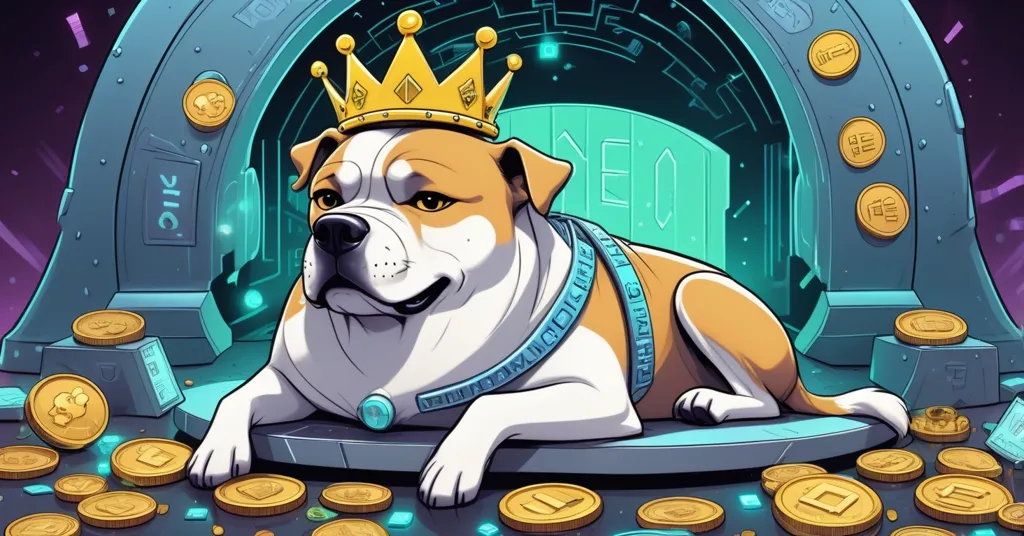Dogecoin Falters as Mutuum Finance Presale Surges: DeFi Innovation or Speculative Trap?

Dogecoin Stumbles as Mutuum Finance Presale Gains Traction—Innovation or Illusion?
Dogecoin (DOGE), the meme coin that once captured the internet’s heart, is showing signs of wear as on-chain data points to dwindling confidence among long-term holders. Meanwhile, Mutuum Finance (MUTM), a DeFi project in its presale phase, is pulling in millions with promises of a groundbreaking lending model. But is this shift a sign of genuine innovation, or just another speculative bubble waiting to burst?
- Dogecoin’s Decline: On-chain metrics like Reserve Risk highlight volatility and fading holder stability.
- Mutuum Finance Hype: Presale raises $18.85M, attracting over 18,120 holders with a dual-market lending pitch.
- Critical Lens: Is MUTM a real contender, or are we chasing shadows in the DeFi gold rush?
Dogecoin’s Downward Spiral: A Meme Coin with Nine Lives?
Dogecoin has been the poster child for crypto’s chaotic charm, skyrocketing to fame on the back of viral memes and high-profile nods from figures like Elon Musk. But the good times seem to be fading. On-chain data, which tracks activity directly on a blockchain’s public ledger, is flashing warning signs. The Reserve Risk indicator—a metric that gauges long-term holder confidence by comparing purchase prices to current value and holding duration—has slipped into the so-called “red zone.” Think of it as a dashboard warning light: when it’s red, trouble’s likely ahead. Historically, this shift signals unpredictable price swings and potential crashes, as holders who once sat tight start eyeing the exit door.
For the uninitiated, on-chain metrics like Reserve Risk offer a window into market sentiment. A high score in the danger zone suggests long-term holders are at risk of selling en masse, often sparking downward spirals. While specific figures for Dogecoin’s current Reserve Risk level aren’t publicly detailed in every dataset, platforms like Glassnode have noted similar patterns preceding major corrections, as seen in the 2022 bear market. This isn’t just a blip for DOGE—it’s a gut check. A coin built on little more than internet jokes and celebrity tweets is now grappling with the harsh reality that hype doesn’t equal staying power.
That said, let’s not bury Dogecoin just yet. This meme coin has defied the odds before, bouncing back from brutal crashes like the post-2021 bull run slump. Its community on platforms like X still clings to hope, often banking on Elon Musk to tweet it back to relevance. Cultural staying power is a real asset—few projects can claim the brand recognition DOGE has. But without a fresh catalyst, whether it’s wider adoption or another viral moment, current data suggests the party might finally be over. Are we witnessing the end of a meme era, or does DOGE have another life left?
Mutuum Finance: The New Kid on the Block
As meme coins like Dogecoin lose their shine, investors are turning their gaze to projects promising actual utility. Cue Mutuum Finance (MUTM), a DeFi venture that’s making waves in its presale phase. Currently in Phase 6, MUTM has raised an impressive $18.85 million and gathered over 18,120 holders. Tokens started at just $0.01. Now they’re priced at $0.035—a 250% jump. With Phase 6 over 95% sold out, the next phase will see prices climb to $0.04. Early investors are salivating over a projected launch price of $0.06, which could mean a 400% return if the hype holds. Numbers like these explain why capital is flowing from stagnating assets like DOGE to shiny new prospects.
But Mutuum Finance isn’t just banking on presale FOMO. It’s positioning itself as a serious player in the Decentralized Finance (DeFi) space, which, for the newcomers, is a blockchain-based system recreating financial tools like lending or savings without banks, putting control in users’ hands. MUTM’s hook is a dual-market lending model. It offers Peer-to-Contract (P2C) lending, where users contribute to pooled liquidity for efficiency—think of it as lending to a big community fund where risks and rewards are shared. It also supports Peer-to-Peer (P2P) lending, allowing customized loan terms directly between users, more like a personal deal with a friend. This setup aims to balance efficiency for major assets like Ethereum (ETH) and Tether (USDT) with flexibility for lesser-known tokens.
The roadmap adds to the allure. MUTM’s V1 Protocol is set to launch on the Sepolia testnet—an Ethereum testing network—in Q4 2025, marking the shift from presale promises to a (hopefully) working platform. To fuel community buzz, they’re rolling out aggressive incentives: a daily $500 bonus in MUTM tokens to the top 24-hour contributor on their leaderboard, and a $100,000 giveaway split among 10 winners, each getting $10,000 worth of tokens. It’s a clever play—build a rabid fanbase fast. But let’s be real: tactics like these often draw in speculators who dump tokens the moment they list on exchanges, leaving true believers high and dry.
Innovation or Illusion? Digging Into MUTM’s Model
On paper, Mutuum Finance’s dual-market lending model sounds promising. Established DeFi platforms like Aave and Compound dominate with pooled lending, offering stability for big assets but less wiggle room for niche tokens. MUTM’s P2C and P2P hybrid could carve a niche by blending the best of both worlds—streamlined liquidity for popular coins and bespoke deals for the underdogs. If executed well, this could address real pain points in DeFi lending, where flexibility often comes at the cost of risk or complexity.
But face the facts: this is all theoretical. MUTM is untested, and the crypto space is littered with projects that dazzled during presales only to fizzle out. Remember Bitconnect in 2017? It promised insane returns, raised millions, and collapsed as a Ponzi scheme, wiping out investors. MUTM’s $18.85 million haul and slick marketing don’t guarantee substance. Transparency is scarce—there’s little public info on the team, no mention of audits, and no working product to scrutinize. Their Telegram channels buzz with giveaway hype, but that’s not a whitepaper. Until the 2025 testnet launch, we’re betting on promises, not proof.
Zooming out, the broader market trend gives context. Meme coins across the board—think Shiba Inu, down over 30% this year—are bleeding value as investors pivot to DeFi projects pitching utility. MUTM is riding this wave, but is it a lasting shift or a bubble in disguise? Presales are notorious for overpromising and underdelivering. The ICO craze of 2017-2018 saw millions vanish into thin air as projects ghosted their backers. Without hard evidence of MUTM’s viability, throwing money at it isn’t investing—it’s gambling with extra steps.
Playing Devil’s Advocate: Weighing DOGE and MUTM
Let’s cut through the noise and stack up the pros and cons. Dogecoin’s struggles are undeniable—on-chain data paints a picture of eroding confidence, and its reliance on cultural hype feels increasingly flimsy in a market craving utility. Yet, DOGE has a track record of resilience. It’s weathered storms that would’ve killed lesser coins, buoyed by a loyal community and brand power. Writing it off based on current metrics alone might be premature, especially if a fresh narrative or adoption push reignites interest.
Mutuum Finance, meanwhile, offers a tantalizing vision. DeFi innovation is desperately needed to disrupt traditional finance, and a dual-lending model could fill real gaps. As a Bitcoin maximalist, I’ll always argue that BTC’s simplicity and security as a store of value remain unmatched. But I’ll concede that not every financial problem should be solved by Bitcoin alone—Ethereum’s smart contracts and DeFi experiments tackle use cases BTC sidesteps, and MUTM could push that boundary further. The catch? It’s a massive “if.” Presale hype, giveaways, and projected 400% returns scream speculative mania. History shows that early investors often get burned when the music stops.
Key Takeaways and Questions for Crypto Investors
- What’s driving Dogecoin’s loss of long-term holder confidence?
On-chain metrics, notably the Reserve Risk indicator hitting a danger zone, signal potential volatility and weakening stability, hinting at mass sell-offs ahead. - Why are investors flocking to Mutuum Finance over DOGE?
With $18.85 million raised in presale and a projected 400% return at launch, plus a novel DeFi lending model, MUTM looks like a fresh alternative to a faltering meme coin. - Does Mutuum Finance’s dual-market lending hold real potential?
Its Peer-to-Contract and Peer-to-Peer approach could balance efficiency and flexibility in DeFi, but it’s unproven until the Q4 2025 testnet launch on Sepolia. - Are presale incentives like MUTM’s giveaways a warning sign?
Yes, they often attract short-term speculators who dump tokens post-launch, potentially tanking value for genuine holders. - Can Dogecoin stage another comeback despite current data?
Possibly—its cultural relevance and community have pulled it through before, though it needs a major spark to reverse the tide.
What’s Next for DOGE and MUTM?
The crypto space moves at breakneck speed, and today’s darling is tomorrow’s dud. Dogecoin’s on thin ice, no question, but its story isn’t over. A tweet from the right influencer or a surprise adoption could flip the script. Mutuum Finance, for all its presale swagger, faces a long road to prove it’s more than hot air. The 2025 testnet launch will be a make-or-break moment—until then, it’s just a pretty pitch.
As champions of decentralization and financial freedom, we’re rooting for innovation to thrive, whether it’s Bitcoin’s rock-solid foundation or DeFi’s bold experiments. But let’s not sugarcoat it: the line between breakthrough and bust is razor-thin. If you’re eyeing MUTM, dig deeper—demand audits, team details, anything beyond flashy giveaways. If you’re still holding DOGE, ask if you’re betting on a meme or a miracle. In this shark tank, only the savvy survive.



